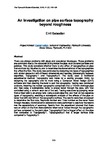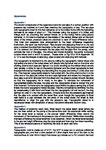An investigation on pipe surface topography beyond roughness
| dc.contributor.author | Sebastian, E. | |
| dc.date.accessioned | 2019-05-21T16:02:55Z | |
| dc.date.available | 2019-05-21T16:02:55Z | |
| dc.date.issued | 2018 | |
| dc.identifier.citation |
Sebastian, E. (2018) 'An investigation on pipe surface topography beyond roughness', The Plymouth Student Scientist, 11(1), p. 170-198. | en_US |
| dc.identifier.issn | 1754-2383 | |
| dc.identifier.uri | http://hdl.handle.net/10026.1/14177 | |
| dc.description.abstract |
There are always problems with pipes and associated blockages. These problems are commonly due to the obstacles sitting inside the pipe, such as sand particles and pebbles. This study considers whether there is any effect of topographies on pipe flow and how big the effect is, and to determine the characteristics of the topographies that affect the flow. The study was conducted by designing two types of topographies with similar shape but with different dimensions and spacing (wavelength) between asperities, Topography-1 and Topography-2. The study used a traditional experimental method. Topography was made by a casting process; firstly, by designing the topography and its mold using a Computer Aided Design (CAD) software and then creating the mold to cast the topography. Testing was conducted outdoors, inserting the rubber topographic component into a 110mm drainage pipe and then using a submersible pump to propel water through the pipe, with flow controlled using a valve in each set of the test. Testing was done by pumping water from a filled tank to an empty tank, using a plain pipe first; and then on two separate types of topography, enabling a subsequent analysis of the effects of the pipe on water flow with and without the topographic surface. The results were then processed to determine the flow rate, Reynolds number and Euler number as the water flows through the pipe. Statistical error calculations were performed to see how the results met the expectations of accuracy. Results from the experiment showed that there was an effect on the flow characteristics when water flowed through the topographic surface compared to the plain pipe. Topography-2 had a bigger effect on the pipe flow compared to Topography-1. Topopography-2 had a larger surface area compared to Topgraphy-1. | en_US |
| dc.language.iso | en | en_US |
| dc.publisher | University of Plymouth | |
| dc.rights | Attribution 3.0 United States | * |
| dc.rights.uri | http://creativecommons.org/licenses/by/3.0/us/ | * |
| dc.subject | pipe surface topography | en_US |
| dc.subject | blockages | en_US |
| dc.subject | Reynolds number | en_US |
| dc.subject | Euler number | en_US |
| dc.subject | plain pipe | en_US |
| dc.title | An investigation on pipe surface topography beyond roughness | en_US |
| dc.type | Article | |
| plymouth.issue | 1 | |
| plymouth.volume | 11 | |
| plymouth.journal | The Plymouth Student Scientist |




